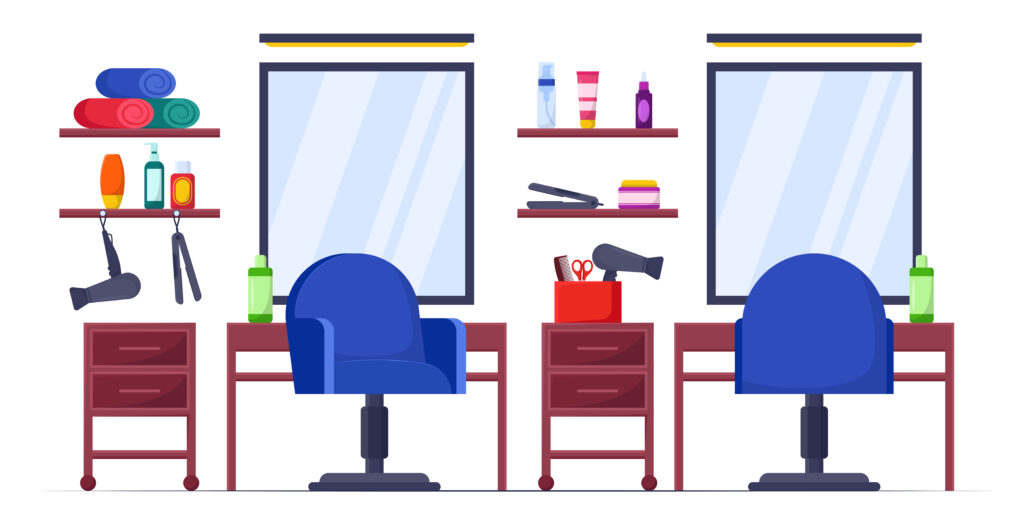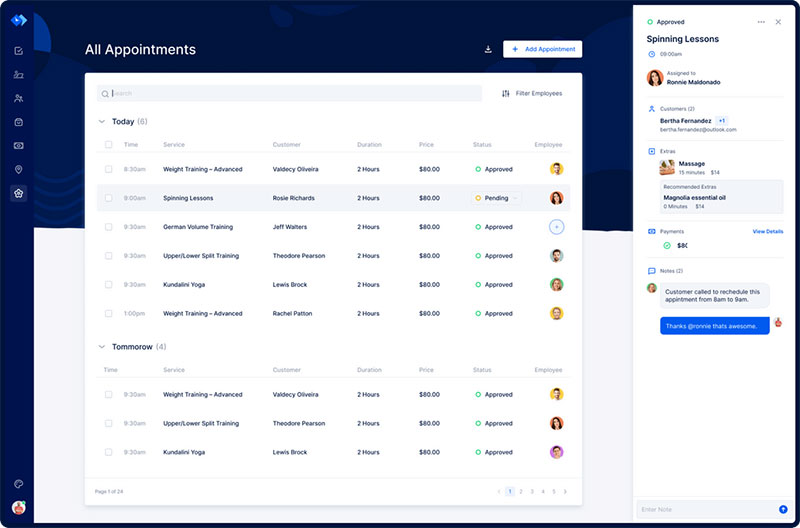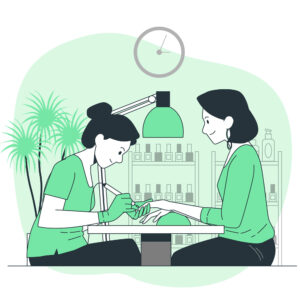If you’ve ever found yourself daydreaming about running your own hair salon, you’ve probably also caught yourself wondering, “How much does it really cost to open a hair salon?”
Well, buckle up, because we’re about to take a laid-back stroll through the world of startup expenses, cash flows, and budget breakdowns. Whether you’re already clutching your hairstyling shears or you’re just toying with the idea of swapping your 9-to-5 for curling irons and hair dye, this article will answer the question of how much it costs to start a hair salon business.
So, grab a seat, keep your hairstylist game strong, and let’s talk about the cold, hard cash it takes to turn your hair salon fantasy into a bona fide business venture.
How Difficult Is It to Open a Hair Salon?
Like other businesses, opening your hair salon can be challenging, so planning is crucial. Ensure your strategy is thought out and covers all critical areas. Doing so will save you time and money.
A well-structured small business plan with a realistic budget will help you keep track of expenses. Include your costs tied to your specific location. Add accurate values for salon insurance, team salaries, professional products, equipment, and decorations.
You must perform in-depth research on the market. But, the more you invest in organizing and developing your hair salon project, the faster you will see it become successful.
What to expect financially? How much will it cost you to open a hair salon?
Let’s delve into the financial side of opening a hair salon – no sugarcoating here, just the facts. Starting a hair salon isn’t a walk in the park, especially when it comes to the dollars and cents. Crafting a solid financial plan for a hair salon business is more than just crunching numbers; it’s a strategic blueprint that can determine whether your salon thrives or barely survives.
Picture this: you’re not only investing in chic salon chairs and high-end products but also shouldering various hidden costs that can swiftly add up. Renting a prime location that attracts clients, obtaining the necessary licenses and permits, and even renovating the space to give it that stylish vibe – all of these require a substantial financial commitment.
Then there’s the equipment. Ever seen a hairstylist snip away with their bare hands? Probably not. Quality scissors, comfortable chairs that don’t cramp your clients’ style, and those powerful hair dryers that seem to possess a Ph.D. in airflow management – they’re essential but also come with a price tag.
But hold on, it’s not all financial gloom and doom. While opening a hair salon might test your budgeting skills, it can also be immensely rewarding. Hard work, dedication, and the right financial strategy can lead to a thriving business and a reputation as the go-to hair expert in your area. So, keep your eyes on the balance sheets and your heart in the game – because with the right approach, you could be on the path to running a successful hair salon.
How Much Does it Cost to Start a Hair Salon Business: Unveiling the Expenses
The total cost to open a hair salon can range anywhere from $50,000 to over $500,000, depending on factors like location, size, scope of services, and the overall ambiance you’re aiming for. On average, though, you should prepare for a significant investment.
Basic costs when opening a hair salon typically include:
- Financing costs
- Costs of setting up the business
- Licenses and permits
- Insurance
- Hair salon software and apps
- Industry-related memberships and fees
- Utilities
- Interior design and renovation
- Furniture and equipment
- Marketing
- Staff costs
- Other expenses
Financing costs of opening a hair salon

Image by vectorjuice on Freepik
More often than not, salon owners need extra funds to complement their savings when they go into business. Since starting costs are high, they might take out a loan at the beginning of their business venture and pay within the first years.
Interest rates go from 1.25% to 10%. They vary depending on the loan duration period, your credit risk, and the current market situation. A detailed hair salon business plan can help convince loan providers to invest in your business and offer better funding conditions.
Fundera is a valuable resource that helps you find the best funding solution for your small business. With it, you can shop, compare, and understand the loaning possibilities available.
Costs of setting up the hair salon business
So, you’ve got a few choices on how to set up shop: buying, renting, building, or joining a franchise. Each option comes with its own financial twist, so let’s break it down.
Buying a space
Alright, imagine owning the space where your salon dreams unfold. Sounds cool, right? And it surely does have its advantages. But here’s the scoop: it’s like buying a big-ticket item. You’re investing a chunk upfront, and although you dodge monthly rent, you also inherit property costs like repairs and taxes. Plus, you’re locked in for the long haul.
The cost of buying a space for a hair salon in the USA can vary widely depending on several factors, including the location, size of the space, local real estate market conditions, and the specific area within the country. The average price you need to set aside for a reasonably sized salon is around $300,000. However, urban areas, high-demand neighborhoods, and regions with a strong economy typically come with higher property prices that can go well above $1 million.
Renting a space
It goes without saying that renting is more flexible. Upfront costs aren’t as hefty, and if the spot doesn’t vibe with your salon groove, you can shake the dust off and move. But beware the rent monster – it can rise over time and nibble away at your profits. And yeah, some landlords might put a lid on your customization dreams.
The cost of renting a space for a hair salon in the USA can vary widely based on factors such as location, size, condition, and the demand for commercial properties in the specific area. The average cost can be anywhere from $700 to $1300 depending on the city, neighborhood, and even the particular street where the space is located.
Building your hair salon from scratch
You’re basically playing architect here. Building your salon from the ground up means you get every brick and brushstroke your way. But (you knew there was a ‘but’, right?), it’s like planning a wedding – costs can sneak up on you like an unexpected rainstorm. Permits and construction hiccups all add up, so you’d have to have a pretty great budget and a thoroughly developed financial plan for your hair salon business.
Joining a franchise
Franchises are like the “plug and play” option. You’re stepping into an established brand with all the bells and whistles – marketing, systems, the works. But, keep in mind, that convenience comes at a cost. Franchises usually want a cut of your pie in the form of an upfront fee and ongoing royalties. Joining a franchise chain can be expensive, with investments ranging from $82,000 to over $1,000,000. But there are numerous advantages to representing a well-recognized brand.
Renting a chair or booth
Alright, imagine renting a space within an existing salon. It’s like being part of a bigger hair family. You pay a regular fee (typically from $75 to $400) to use the space and facilities. It’s usually less pricey than renting a whole shop, but it might not have that “all mine” feeling. You’ll likely have more freedom for customization than renting a shop though.
Starting a mobile hair salon
Going mobile means you’re like a hair magician on wheels. You take the salon to your clients, which can be a cool and convenient twist. You save on rent costs and the overhead of a fixed location, but remember, there’s a “gas and go” aspect. You’ll need to budget for travel, equipment, and maybe permits depending on where you operate.
As you weigh these choices, remember to do the math. Crunch the numbers, think about the long game, and consider how each one aligns with your wallet and your salon dreams. Whether you’re buying, renting, building, or franchising, it’s all about finding the right fit for your hair salon adventure.
Costs of obtaining the necessary licenses and permits
Opening a hair salon requires several licenses and permits to ensure that your business operates legally and meets health, safety, and zoning regulations. The specific licenses and permits can vary based on your location and the services you plan to offer.
Some common licenses and permits you might need are:
- Business License – ranges from $50 to a few hundred dollars;
- Salon Establishment License – ranges from $100 to $1,000 or more;
- Cosmetology License – ranges from $50 to a few hundred dollars per stylist;
- Health Department Permit – ranges from $50 to a few hundred dollars;
- Zoning Permits – range from $100 to a few hundred dollars;
- Signage Permit – ranges from $50 to $200.
- Fire Department Inspection – ranges from $100 to $300;
- Music Licensing – ranges from $100 to a few hundred dollars annually;
- Alcohol and Food Permits – range from $100 to several hundred dollars or more.
The expense of getting a hair salon insurance
Insurance is critical for any business. Hair salons can expect to pay $50 to $1000 monthly for insurance. But the average is $240, making up $2900 per year.
In this case, expenses will depend on more than the size of your salon and its location. The type of equipment you work with and your number of employees are also determining factors.
Salon insurance fees can be pricy, so you might try combining various policies from a single insurance company to reduce costs. For example, join the commercial property insurance and general liability insurance.
Forming a package will allow you to ensure proper coverage for your business. At the same time, you can access more beneficial terms and stay within budget.
The budget for hair salon software and apps
Choosing the proper software is a stepping stone to success. Most salons install a plain Point of Sale System (POS) to process transactions.
However, a more comprehensive software solution can help improve salon business performance. Hair salons lose £1.2 billion yearly because of missed appointments, according to the Hairdressers Journal (HJI).
To avoid these losses, you can use a reliable booking solution that acts as your virtual front desk that never sleeps. With just a few clicks, you supercharge your salon with a powerful tool that keeps missed appointments at bay.
And one such tool is Trafft.
Trafft: Booking and beyond
Are you familiar with the sinking feeling of a no-show? Yeah, we’ve all been there. So, what if there was a way to combat that? That’s where Trafft steps in.
Picture this: Your day streamlined, your appointments organized, and your calendar flawless. Yes, you heard right! That’s the beauty of Trafft.
Your salon’s efficiency, dialed up to eleven.
- Never miss a beat with our smart reminders. Customers forget? Not on Trafft’s watch! Timely reminders help your clients stay on track.
- Our seamless scheduling is like a breath of fresh air. Say goodbye to double bookings. Trafft’s got your back.
- We also handle your customer database. All the nitty-gritty details? We keep them organized so you focus on what truly matters – your craft.
With Trafft, it’s not just about filling those seats; it’s about creating a more effective business model. Our tool doesn’t just stop at scheduling; it goes beyond, revolutionizing the way you manage your salon.
Imagine an increased customer satisfaction level, fewer headaches from logistical issues, and more time to concentrate on offering your customers the premium service they love.
What’s not to like?
Trafft is not just an investment; it’s a game-changer. For your salon. For your customers. For you. Let us help you take your business to the next level.
Choose Trafft. Choose excellence. It’s about time you stepped into the future of salon management. Step in with us. Your journey to a more efficient, more prosperous salon begins now.
Industry-related memberships and fees
Connecting with industry-focused organizations can help any new or existing salon grow. Try to find out what associations operate in your region or turn to renowned institutions, like:
- The Professional Beauty Association (PBA)
- Associated Hair Professionals (AHP)
- The Professional Beauty Federation of California (PBFC)
Doing so will bring about valuable networking opportunities. It will also help you stay up-to-date with new tools, trends, and techniques. However, there might be membership costs you will have to support. But these expenses are insignificant compared to the advantages they offer.
Utilities
A hair salon business needs water and electricity to operate. Those ongoing costs are vital but seize a significant portion of the monthly revenue, between $640 and $4,000. Expenses with utilities vary according to the type of equipment you have, your opening hours, and your location.
For example, setting up TVs for the clients and staff or having too much lighting in your salon will increase the electricity cost. Contrarily, using beauty magazines, LED lighting, and choosing a property with plenty of natural light will reduce it.
With fewer hair salons using gas, the next big concern is water spending. Fixing leaky taps immediately and choosing water-saving options can help control them.
These and other measures are often considered ecological efforts. Regardless, as a salon owner, you will notice they benefit both the environment and your wallet.
Interior design and renovation expenses
The costs of opening a hair salon also depend on whether you decide to fix the place up. The cost of hair salon renovations and design depends on different factors, such as the scope of the project, location, size of the salon, materials used, and the extent of changes required. Let’s take a look at the overview of potential costs and common renovation and design elements:
Renovation costs:
If you’re looking at minor updates like repainting, changing lighting fixtures, or updating furniture, the cost could range from a few hundred to a couple of thousand dollars.
For more comprehensive renovations that involve new flooring, updated stations, and improved plumbing, you might be looking at a range of $10,000 to $30,000.
A complete salon makeover that includes structural changes, reconfiguration of space, high-end finishes, and advanced technology integration could cost upwards of $50,000 or more.
Design costs:
The cost of hiring an interior designer for a consultation could range from $50 to a few hundred dollars per hour. They can provide ideas, concepts, and recommendations.
Hiring an interior designer for a comprehensive design package that includes space planning, concept creation, material selection, and project management might cost around $1,000 to $10,000 or more, depending on the complexity of the project.
Common renovation and design elements:
- Flooring: Upgrading flooring materials such as hardwood, tile, or vinyl can completely transform the overall look and feel of your hair salon. Costs can vary based on the type of flooring chosen.
- Stations and furniture: Upgrading or replacing hair stations, chairs, mirrors, and waiting area furniture can range from a few hundred to several thousand dollars per piece.
- Lighting: Changing lighting fixtures to create different moods or improve visibility can cost anywhere from $100 to $1,000 per fixture, depending on the design and quality.
- Color palette and paint: If you want to give your hair salon a fresh look, consider repainting it with a new color palette. Costs depend on the size of the space and the quality of the paint.
- Cabinetry and storage: New cabinets for your storage or display area can range from a few hundred to a few thousand dollars, depending on the size and materials used.
- Plumbing and electrical: If you’re reconfiguring plumbing or electrical systems, expect your costs to skyrocket.
- Décor and accessories: And finally, costs for decorative elements such as wall art, plants, and decorative accessories vary and can literally range from a few bucks to costing you an arm and a leg.
Remember, these figures are rough estimates. The actual costs can be much higher (or, hopefully, lower), depending on what you do and how you do it.
Costs of buying hair salon furniture and equipment

Image by Verazinha on Freepik
When opening a hair salon, expenses that go with furniture, equipment, and other supplies entirely depend on your business concept.
Let’s try to give you an idea of what you might need:
- Chairs and stations: The chairs where clients sit and the styling stations where hair magic happens can cost around $100 to $1,000 each. Quality and design influence the price.
- Mirrors: Mirrors for each styling station might run you about $50 to $200 per mirror, depending on size and style.
- Shampoo stations: For those relaxing hair washes, a shampoo station can be around $300 to $800 per unit.
- Dryers and hair processors: Equipment like hair dryers and processors can range from $100 to $500 or more per unit.
- Reception area: Furniture for the reception area, like chairs and a desk, can total around $300 to $1,000 or more, depending on the look you’re going for.
- Waiting area: If you want comfy chairs or benches for your clients to wait, it might cost you around $50 to $300 per piece.
- Storage and display: Cabinets, shelves, and display units for products can range from $100 to $500 or more, depending on size and quality.
- Tools and accessories: Hairdryers, straighteners, curling irons, and other tools might cost about $20 to $200 each, depending on the brand and features.
- Washing and rinse equipment: If you need washing basins and rinse equipment, they can be around $200 to $500 per unit.
- Decor and extras: Don’t forget little things like décor, mats, and other extras. These could be around $20 to $100 per item.
These are ballpark figures and costs can vary based on brand, quality, and where you’re shopping. It’s a good idea to research and shop around to find the best deals that fit your budget.
Purchasing brand-new vs. second-hand salon equipment
If you’re all in for that fresh-out-of-the-box vibe, buying new salon equipment can be your thing. It’s like getting that new car smell but for your business. The pros? You’re the first to use it, and there’s usually a warranty in case anything acts up. The downside? Well, it can be pricier, no doubt.
If you’re looking to save some money, then second-hand gear might be a better option. It’s like finding hidden treasures at a thrift store. You can find some really quality gear at a fraction of the cost. But of course, there’s a flip side. It might not be as shiny, and you should be extra careful about checking for wear and tear.
It all boils down to your budget, style, and what you’re looking for. Whether it’s the crisp allure of new gear or the thrill of scoring a deal, the choice is all yours.
Marketing expenses when opening a hair salon
Marketing is essential for any new or existing hair salon. It’s what helps you stand out in the crowd and reel in those new clients.
That’s why you should set a specific amount of funds aside for your marketing strategy. Count in things like ads, discounts you might toss out there, and the fun stuff you’ll do at the salon.
Here’s what you need to rock your marketing game:
Branding
Your salon needs a look that screams “You know you wanna come here!” So, grab an eye-catching logo, colors that pop, and cool fonts. Use this branding on everything from your business cards to your behind-the-scenes paperwork.
Print advertising
Ever thought about printing flyers and brochures? They can hit the streets even before your salon opens. It’s like giving everyone a sneak peek of what you’re about to bring to the table.
Digital marketing
The online world’s where it’s at. Get yourself a website – that’s like your online salon hub. Showcase your services and introduce the team like rock stars. Oh, and don’t forget the social media game. Post fun stuff, chat with your clients, and toss some online ads into the mix to catch even more eyes.
Business website
Running a hair salon isn’t just about the physical space and word-of-mouth anymore. Having a website is key – it boosts your online presence, enables your business to be online 24/7 through online bookings, and brings your brand to life.
If you’re not the tech-savvy type, don’t worry – you can hire pros to create the website for you. However, that can be costly.
So, here’s a simpler route: use an easy website builder. Add in your brand stuff, and here’s the cool part – hook it up with your hair salon booking system. Clients can use your booking page to book online and pay right there.
Just keep in mind that even if your website is simple, your brand should shine through. People should know it’s your salon when they see it.
Hair salon employee-related expenses
Certification
Certification is mandatory to open a salon and should be a priority for you as an owner. They build trust with customers and give your reputation a boost. Besides, the law also requires some industry-related certifications and licenses.
When you’re building a team for your new hair salon, focus on professionals with a cosmetology license. If you hire someone still studying, make sure they’re on track to get their license soon.
Salaries
Staff salaries are the highest expense for most salon owners. It’s where most of your cash goes. How much? Well, that depends.
Everyone gets paid based on their job position, skills, and experience. You can choose to pay your team members by the hour or on a commission basis.
But don’t just throw out numbers – do some homework. Check what the going rates are in your area and your market. You want to offer good money to get good people and ensure they stick around. And consider throwing in some extras like health insurance to sweeten the deal.
Training
In this hair game, things keep changing. Trends and tricks are always popping up. So, keep your team in the loop with training. It’s how you keep up and offer top-notch services.
Look for training that matches your team’s skills. It’s a win-win – they’ll be able to evolve professionally, while your salon will get to shine. Research programs that have a strong reputation and are trustworthy. Learn about workshops that will happen near you. And sign up for industry newsletters that might advertise an upcoming course.
When you first hire someone, you should understand their goals and aspirations. Then, maintain open communication and encourage them as they chase their goals. Trust, support, and motivation – that’s how you build a strong team.
Other costs when starting a hair salon business
All these costs are part of the answer to how much opening a hair salon costs. Yet, miscellaneous expenses are one more thing you should consider.
You might need sudden maintenance or repairs, or a part of the equipment can break down. You could face unexpected circumstances that force you to close doors temporarily. These expenses are impossible to predict but might end up costing you quite a bit.
One of the best tips to put into practice is creating a buffer budget. Having a reasonable amount of money saved for emergencies and inconveniences will help you stay calm and prepared. Even if your savings do not reach the funds lost, they will be a welcome safety net.
FAQ on the Costs to Open a Hair Salon
How much to open a hair salon?
Setting up a salon is like investing in your dream. It’s not a one-size-fits-all price tag. Costs depend on several factors like location, salon size, types of services, and equipment needed.
Opening your hair salon could be anywhere from a few tens of thousands to several hundred thousand dollars. The key is to plan wisely and create a solid financial plan for the hair salon business. And remember, it’s an investment that pays off with the right management.
How much do I spend on salon equipment?
Your tools, your trade. You need high-quality equipment that lasts and adds to the client’s experience. Think chairs, mirrors, washbasins, hairdryers, and the like.
Costs can vary but count on spending a good chunk of your budget here. Remember, it’s not an area to skimp on. Your equipment is the backbone of your service.
What will be the renovation cost?
Creating the right vibe takes work. Renovation costs depend on the condition of your location and your vision for the space. Are you doing a complete overhaul or a minor facelift? Factor in flooring, lighting, paint, and any structural changes. Your salon should be a space where clients feel pampered and relaxed.
Do I need to budget for licensing and permits?
You bet. Operating a salon requires several licenses and permits – business license, cosmetology license, building permits for renovations, and so on.
The costs vary depending on your local regulations. So, do your research and factor these into your budget. They’re essential to opening your doors and keeping them open.
What about initial inventory costs?
Your shelves can’t be bare. You need an initial stock of products for services and retail. The cost depends on the brands you choose and the variety of products you offer.
Plus, remember to include storage units in your calculation. Smart inventory management can keep costs in check once you’re up and running.
How much do I invest in software and technology?
In this digital age, software is a must. You’ll need systems and apps for scheduling, inventory, payroll, and more. The costs can range from a monthly subscription fee to a larger upfront investment.
But remember, it’s an investment that can save you time and money in the long run.
What are the costs involved in hiring staff?
Your team, your biggest asset. You’ll need to budget for salaries, training, and benefits. Plus, consider the costs of recruitment and any uniforms.
The exact cost depends on the number of staff and their experience levels. It’s important to pay competitively to attract and retain talented stylists.
Do I need to spend on marketing initially?
Getting the word out is key. Budget for branding (logo, signage), a website, and social media advertising. Don’t forget about a launch event or initial promotions to attract your first clients. Marketing is an ongoing cost, but it’s essential to build your clientele and keep them coming back.
Should I consider insurance costs?
Absolutely! Insurance is a non-negotiable. It protects you and your investment. You’ll need liability insurance, property insurance, and possibly others depending on your situation.
Costs vary, so shop around and find a policy that fits your needs and budget.
What should be my budget for utilities and ongoing expenses?
Keeping the lights on costs money. Factor in utilities like electricity, water, and internet. Don’t forget about ongoing expenses like cleaning, maintenance, restocking products, and recurring marketing costs.
These costs may seem small, but they add up. It’s essential to account for them in your budget.
So, How Much Does it Cost to Open a Hair Salon?
You’ve dug right into the ins and outs of opening a hair salon. Now you know how unstable costs can be and why research is key.
So, what would you say? How much does it cost to open a salon? You can find out by planning your business in detail, defining your concept and services, and choosing a location. These factors will reveal your final upfront costs and impact your recurring ones.
As you prepare to open a salon, refer to accredited organizations and experienced professionals. They will provide the guidance you need from the start-up phase until your business becomes profitable.
If you enjoyed this article on how much to open a hair salon, check out these:
- How to Remind a Client to Pay You: Tips & Templates
- How to Fire a Hair Client?
- Conversion Rate Optimization Tips to Increase Online Bookings





